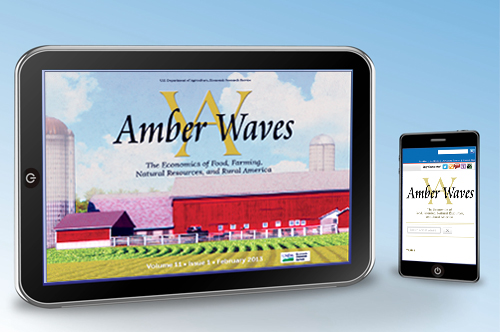
This post is part of the Science Tuesday feature series on the USDA blog. Check back each week as we showcase stories and news from USDA's rich science and research profile.
Amber Waves, the flagship magazine of the Economic Research Service has embraced the digital age with its recent launch of a mobile application that readers can download free on iPads and other tablets. It’s among the first government magazines to be available via a mobile app. Readers can now access the magazine on the bus or metro, on a plane, in the classroom – essentially anywhere and anytime - with a touch to their screen.
The widely read Amber Waves functions as a window into the research and analysis our agency conducts on the food sector, agriculture, rural America, and farm-related environmental topics. The magazine presents data and research findings in an engaging, tightly written, and visually interesting style for an informed but non-specialized audience.
The new Amber Waves initiative is part of a much broader cultural shift from print to digital material, with briefcases of reading materials increasingly replaced by compact tablet computers. More and more Americans are using mobile devices to read books and magazines, get their news, do research, and conduct business. We saw the need to adapt – to technology and to users’ needs. Our effort, which involved a large team from across the agency, is part of USDA’s overall Digital Strategy – using 21st century technology to enhance delivery of information and services.
While Amber Waves began as a print-and-internet product 10 years ago, we had already moved to web-only publication by 2012. Recently, our readers have told us that they want the ability for offline reading - accessing the magazine without internet or cellular connection. A typical reader might be a Government program manager using ERS information to prepare a nutrition program presentation, a reporter looking for background on rice trade, a legislative assistant writing a farm-related policy brief, an agribusiness manager tracking developments in the farm economy, or a teacher preparing a lecture on water quality.
The new app better serves these readers, who are often busy and not tethered to a computer. They can download the app on their iPads, or on their Android tablets – and eventually, on other digital devices. The magazine will arrive on mobile bookshelves quarterly, combining the features of a tablet with the page-through experience of a standard magazine.
We expect our web edition to continue its popularity. In tandem with introduction of the mobile app, we’ve begun monthly additions to Amber Waves content on the Internet. And we’ve redesigned the web edition to automatically configure to fit tablets and other mobile devices. In short, we’re providing more ways for Amber Waves readers to stay connected.
On National Ag Day, USDA's Research, Education, and Economics science agencies are sharing four blogs highlighting the importance of innovation and research to food and agriculture. To see more, click here.
